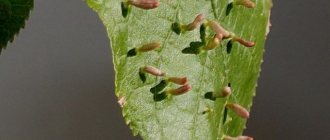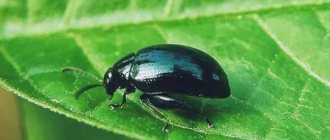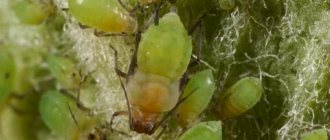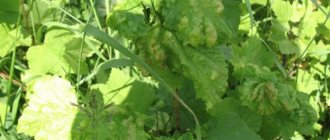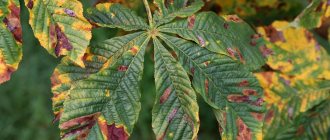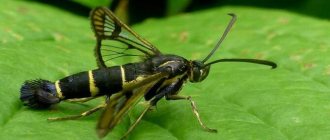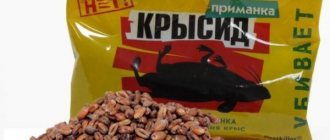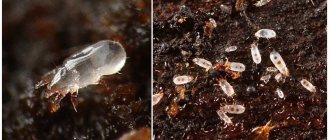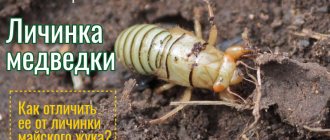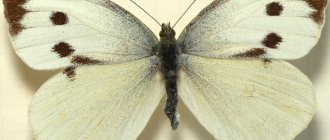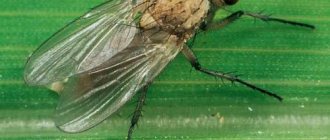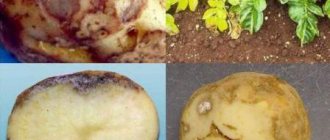Phylloxera is a grape pest that affects the leaves, roots, and cuttings of the plant. It feeds on various varieties of grapes; American varieties are more resistant to the root form of the pest, and European varieties are more resistant to the leaf form. In a short time it can lead to the death of the entire vineyard. In this material we will look at what grape aphids are, what types of this pest exist, how to determine the presence of insects on grapes, what measures need to be taken in order to quickly and effectively destroy insect colonies on grapes, as well as prevent their appearance on your site.
Damage caused by phylloxera
By injecting into the root tissue, phylloxera secretes saliva, the enzymes of which cause malformations of the root tissue, deformation of the root tissue at the injection site. On thin, fibrous roots, swellings and nodules appear, called “beaks” (nodosites), which soon die. On thicker conductive roots, thickened growths-nodules (tuberosites) are formed, on which cracks appear over time. However, we must remember that phylloxera itself is not the only cause of the death of roots and the death of bushes putrefactive bacteria and saprophytic fungi penetrate into these cracks , which play a decisive role in the rotting and subsequent death of roots.
The formation of nodules on the roots of grapes makes it difficult to absorb nutrients and may even stop it completely. Nodules on stronger roots isolate entire groups of roots and cause them to die, as a result of which the bush can no longer meet its need for nutrients from the soil, starves and finally dies.
The death of grape bushes after damage by phylloxera can occur after 3-5 years in young plantings of grape bushes and much later in older plantings. The period will depend on the specific unfavorable other conditions in the vineyard (soil, fertilizer, climate). The period of bush death depends on the genetic resistance of the variety. There are unstable varieties (most European varieties, Amur grape varieties, European-Amur hybrids, etc.), there are tolerant (relatively resistant) varieties - such as Moldova, Augustin, Valentina, Bianka, Podarok Magaracha, Firstborn Magaracha, Tsitronny Magaracha, Frontignac and its variations (Frontignac gris, Frontignac blanc) and some others (mainly European-American hybrids and hybrids of complex interspecific origin).
Only American grape varieties , which we use as rootstocks, and some hybrids from direct producers can be considered resistant to phylloxera Why are they considered sustainable? The point is not that phylloxera does not feed on their roots, but the point is that their roots, although infected with phylloxera, are resistant to the process of root rot . The American grape species Vitits labrusca L. is considered the least resistant to phylloxera among other American grape species, which also applies to hybrids obtained with its participation (varieties Isabella, Lydia, Concord, etc.). However, this species is still more resistant than European grapes
Prevention
“Any disease is easier to prevent than to treat” - Hippocrates’ statement should be considered fundamental in the prevention of phylloxera infection. To prevent the disease, the following actions are recommended:
- buy seedlings for planting from trusted sellers, trying to avoid regions affected by phylloxera;
- before planting, the roots are disinfected with a 24% emulsion of the gamma isomer of hexachlorocyclohexane;
- the top layer of soil is replaced with sand;
- plant varieties resistant to phylloxera;
- promptly trim damaged surface roots;
- plant petioles deeply;
- in difficult soil, when planting, sprinkle the root with a layer of sand;
- uproot old grape bushes.
Important!
For work, use equipment that has been mechanically cleaned and disinfected.
Phylloxera infection
During the initial infection, the pest’s activity becomes noticeable, primarily by weakening the growth of the above-ground part of the bush. The growth becomes weak, the shoots ripen poorly, the leaves and clusters become smaller, the crop ripens poorly and becomes of poor quality. Such weak, poorly ripening shoots often die from winter frosts. Since phylloxera from an affected grape bush spreads first of all to the neighboring grape bush, a picture of a “circular focus” often appears. In the progressive stage, the grapes in the center of the outbreak die off faster. Then a zone of grapes appears, which already bears, to a greater or lesser extent, traces of damage and withers. There is especially a lot of phylloxera on the outskirts of the zone with apparently healthy grapes. Leaf phylloxera itself, when infested en masse, impairs photosynthesis, weakens the growth of the grape bush, slows down the ripening of shoots and leads to a decrease in yields.
Important! The most likely sign of infection of grape bushes with phylloxera is a weakening of annual growth for no apparent reason.
If you notice a weakening of the growth of grape bushes on your site, then to check the suspicion of the presence of phylloxera, you need to excavate the roots . To do this, carefully dig a hole on the side of the bush and examine several thin and thick roots. If during inspection you find swellings, nodules, nodules, etc., as well as rotting root cavities, then you need to know that you can only say that it is phylloxera when you use a magnifying glass to find the corresponding larvae or eggs !
Why? Because similar damage can also occur from nematodes. Read a great review about nematodes here: Nematodes in the vineyard
And of course, we should be concerned about the appearance of the leaf form of phylloxera. This is already a danger signal! There is one more important point. Many people confuse the leaf form of phylloxera with the manifestation of damage to the leaves by itching (grape felt mite) and begin to panic ahead of time.
However, there are differences, and they are cardinal (see photo).
In the photo: 1 - upper side of a grape leaf affected by itching 2 - lower side of a grape leaf affected by itching. Photo by S.I. Krasokhina
In the photo: 1 - the upper side of a grape leaf affected by the leaf form of phylloxera 2 - the lower side of a grape leaf affected by the leaf form of phylloxera. Photo by S.I. Krasokhina
Effects on the harvest
The defeat of a vineyard by a pest leads to the gradual death of shoots, which halves the yield in the first years. In the future, the yield of the affected bush will decrease in proportion to the degree of damage to the plant. When bushes are infected with the gall form of the parasite, the developing clusters can be destroyed, which means that the gardener will not receive a harvest of the specified crop at all. Tempranillo is the most susceptible variety to phylloxera.
The only way to save it is to treat the crop with fungicides.
If the roots of the plant are damaged, in the third year the grape bush dries out and dies completely. There can be no talk of any harvest in this case.
Lifestyle and forms of the pest
The life cycle of phylloxera is extremely complex. There are exclusively underground or aboveground forms, as well as those that provide a connection between these forms (complete and incomplete development cycle of phylloxera).
Root form
The aphid form, found only on roots and underground organs, is all female without exception. They are wingless, yellow-green to brownish in color and are equipped with small, symmetrically located dark dots on their backs. The body has a broad ovoid shape. A long sucking proboscis extends from the head to the abdomen. Both three-membered tentacles and six legs are short. Using a magnifying glass, you can see three pinhole eyes on each side of the head. Aphids that have just hatched from eggs reach a length of 0.35 mm. After molting four times, adults reach a length of no more than 1.35 mm.
The root form pierces the roots of the grape bush with its proboscis to suck out food. Thanks to the components of saliva, curved or elongated swellings called beaks appear at the ends of fibrous roots, and flat or thickened growths called nodules form on older parts of the roots.
Unfertilized females lay clusters of oval yellow eggs for 4-6 weeks. The average size of the testicles is 0.32 mm, and their width is half that. The number of eggs varies significantly. Under favorable conditions, overwintered aphids lay up to 800 eggs, and sometimes even more, but the three subsequent generations lay fewer eggs. With poor nutrition on low-susceptible (tolerant) grape varieties or with overpopulation, the number of eggs is reduced to a few. As the eggs age, they turn olive to brownish-green. The duration of development depends on temperature and averages 8-10 days.
Every year the root form usually produces 5-6 generations. Already at the height of summer, but especially in autumn, phylloxera larvae with a particularly long proboscis hatch from the eggs. They feed mainly on older and less often on young grape roots and attach themselves to them in order to spend the winter without moving and retracting their tentacles. Overwintered larvae are resistant to low winter temperatures. As soon as the weather warms up, they begin to pierce the root tips and develop into female aphids, which begin laying eggs from late May to early June. Thus, we are talking about a non-sexual life cycle that takes place exclusively in the soil.
Development cycle of grape aphids
There are two development cycles for phylloxera.
Full
The full cycle characteristic of American varieties begins in the spring. The larva, emerging from the winter egg, crawls onto the leaf, sticking to it. The root species of the pest partially emerges from the formed gall. Aphids descend underground and continue to damage the rhizome.
Incomplete
On European varieties, aphids develop in an incomplete cycle. Infection begins immediately from the roots. Larvae emerge from the eggs laid by the female. Moving underground, they infect new bushes. In autumn, most of the pests die. Overwintered first generation larvae continue to reproduce next year.
Winged form
Important! The natural spread of phylloxera occurs through the winged form, which gives rise to the leaf and then the root form.
During the summer and early autumn, thinner orange individuals are found among the root aphids, distinguished by lateral darkish wing buds above the middle pair of legs. Here we are talking about the so-called nymphs. They develop especially a lot on some American grape varieties (rootstocks) when the weather and humidity are favorable.
Nymphs climb to the soil surface, and after the fourth (last) molt they transform into a winged form. They are about 1 mm long, yellow-green to ocher in color, have well-developed eyes, long tentacles, and significantly longer legs. Equipped with two pairs of wings, they can fly short distances. Like the root form, they are always female and lay unfertilized eggs of two sizes in small numbers, mainly on the loose bark of old wood and only as an exception - on the underside of leaves near the veins, or on the buds. However, they tend to prefer American grape varieties and interspecific hybrids, which they detect with a well-developed sense of smell.
Sexual generation
Smaller eggs laid by the winged form hatch into male larvae, and larger ones into female ones, which go through four molts until they reach the adult stage and reach sexual maturity. Intense yellow males are 0.28 mm long, while light yellow females are almost 0.5 mm long. The sexual form has neither wings nor proboscis, so they cannot feed. Despite this, they live eight days and sometimes even longer. After fertilization, generally the only sexual act in the phylloxera life cycle, each female lays a single fertilized egg in the crevices and cracks of old, most often two- or three-year-old wood. This so-called winter egg is olive to brownish in color, 0.27 mm long and half as wide.
Leaf (gal) form
The following spring, at the beginning of shoot growth, a single wingless, always female aphid, called the May gall aphid, or progenitor, hatches from the winter egg. Previously, it was believed that it could only live on the leaves of American grape varieties and hybrids, but not on European varieties. However, there is now a lot of evidence that leaf phylloxera can also be found on European grape varieties. On European grape varieties, the pest spreads with the help of migratory larvae (vagrants) of the root form, moving short distances from bush to bush along cracks, along roots underground and along the soil surface.
The photo shows the leaf form of phylloxera on the European variety Kishmish white, photo by S.I. Krasokhina.
The gall-forming form settles firmly on one of the first six leaves (usually leaves 2-5) and begins to suck on the upper side of the leaf. At this point, on the underside of the leaf, the leaf forms a concave green or sometimes even reddish gall, which surrounds the aphid and can be the size of a pea (May gall). The connection with the external environment is maintained through the hole at the top. Upward hairs prevent access by other insects
In the photo - the so-called May gall on the leaves of the rootstocks, photo by S.I. Krasokhina.
In the gall, the May gall aphid lays up to 1,200 yellow-green oval eggs over several weeks without fertilization. On tolerant grape varieties and with poor pest nutrition, this number can be significantly lower. After 8-10 days, young aphids hatch, leave the gall through a hole on the upper side of the leaf and crawl up the shoot to settle on young, not yet fully expanded leaves and form new galls. It is these young aphids that are called leaf form . Between the leaves with May galls and the leaves with galls from the second generation of aphids, there are always leaves without galls, which developed in the period before the appearance of aphids from the May galls. Second generation leaf aphids settle on the 7-22nd leaf, most often the 9-12th leaf, of green shoots, starting in mid-July. The further, third generation forms galls on the 18-20th leaf. Typically, the appearance of leaf-shaped galls can be observed at the end of June and July. Under favorable weather conditions, another fourth, perhaps even a fifth, generation may appear, so that eventually all the young leaves are covered with galls, although the average number of eggs laid by older aphids decreases from generation to generation. When the bushes are very heavily populated with galls, even the tendrils, petioles and ends of the shoots become covered and deformed (see photo).
Photo by S.I. Krasokhina
If for some reason the May gall-forming aphids cannot normally exist on American grape varieties, it sometimes happens that the leaf form of subsequent generations migrates to neighboring European varieties growing next to infected American varieties or hybrids and forms galls on them.
Starting from the second generation, in the galls, along with the leaf form, which causes the formation of new galls on the leaves, by autumn, increasingly large masses of aphids appear, whose bodies are stronger and have a longer proboscis. Such forms appear starting from the fourth generation. We are talking about root aphids that hatch in the leaves , which migrate into the soil from the leaves , there they look for the roots of the bush, where they continue to live. The leaf form, on the contrary, dies during the period of leaf fall. Thus, they emerge again each year in a cycle that includes winged aphids, a sexual form, and winter eggs. It has not been proven that under natural conditions the root form directly migrates upward and forms galls on the leaves.
Along with the simple cycle occurring entirely underground, where one generation after another of the root aphid follows, there is also a large complex two-year cycle from the root form and nymph , occurring above the ground through the winged and sexual forms, the winter egg, the leaf gall form and through the hatching in leaves root form back into the ground. That is, phylloxera has two development cycles and only one individual is enough to renew the population.
Choosing the best variety for your site
Experts recommend choosing European grape varieties, since they are practically not exposed to the harmful effects of the root type of phylloxera. It is better to plant grape seedlings on sandy soils. The most resistant to parasite infestation:
- new varieties or hybrids of Save-Villars;
- Kober 5bb (Austria), rootstock vines of Riparia Gloire, (France) Riparia x Rupestris 101-14.
The root system of the listed items is difficult to rot.
Grape phylloxera is a dangerous pest that is very difficult to get rid of even for a professional gardener. Therefore, before planting grapes, you need to make sure that the vine was taken from a healthy bush, from a trusted seller, and that the selected variety is resistant to the effects of the parasite. Following simple rules for disease prevention will help keep the vineyards healthy and produce an impressive harvest.
Races of phylloxera
Like other living beings, phylloxera also appears in different races and biotypes, which is evident from the unequal ability of the pest to colonize the so-called leading varieties. The previously held and perhaps correct idea that this physiological differentiation is associated with such external characteristics as, for example, the length of the piercing setae, can no longer be supported. If today people still sometimes talk about short-proboscis and long-proboscis phylloxera, then the former is understood as a more aggressive race of phylloxera with a wider range of inhabited grape varieties.
Reasons for appearance
Various factors can provoke the formation of a pest.
Violation of agricultural cultivation techniques
Before planting grapes, it is necessary to neutralize the planting site, this will reduce the risk of infection with grape aphids. Infection can also occur as a result of a lack of the required amount of nutrients. Infected crops do not have immunity to fight the pest and die.
Wrong choice of planting material
The reason that provokes infection of the crop is incorrectly selected planting material. Pest eggs can remain dormant for several years and hide on seedlings.
The insect also causes a rotting process, which leads to the complete death of the roots.
Important. Infected grapes should not be used as a mother bush.
The larvae can move along with the cuttings and attack the seedling.
Infected inventory
Before each crop treatment, it is necessary to process the equipment that is used. Very often, pest eggs are hidden in the ground and can settle on a shovel.
Distribution of phylloxera
The spread of the pest over short distances can occur due to the active movement of young root and leaf aphids, as well as winged aphids.
Immediately after emerging from the egg, the root form is quite mobile and goes into the soil in search of new grape roots, using cracks and crevices in the ground for this purpose. Sometimes it can end up on the surface of the earth, where it can move for hours at a maximum speed of 3 cm/min, without rest and without food. The same applies to the leaf form and root form of aphids hatching in the leaves, which can travel significant distances for their size. It has been proven that the winged form can fly distances of up to 100 m.
In the spread of phylloxera, the greatest importance, undoubtedly, is its passive transfer. Individuals crawling along the soil surface can be moved by rainwater or mud flow , but they are carried over particularly long distances by wind . The winged form is carried by the wind for many kilometers, and it has been proven that even at a distance of 30 km , and probably much more, such transfers caused infection in plantings of American varieties, rootstocks and hybrids of grapes. Winged forms give rise to the sexual generation. Root-form larvae can also move from bush to bush underground and along the ground. People themselves contribute most to the spread of the pest . The spread of phylloxera to new grape growing areas can occur through transfer on the tools, shoes and clothing of winegrowers. So, the main ways phylloxera spreads :
- planting material
- the soil
- wind
- tools
Animals (eg rabbits, birds) also contribute to the transmission of the pest.
Preventative work
In most cases, keep seedlings in quarantine before planting. Keep seedlings in quarantine before planting. Carry out preventive treatments in the spring. They need to be done three times: after 3-5 leaves appear on the branches, after flowering begins, after grape bunches begin to form.
- Follow the rules of agricultural technology when planting grapes. It is advisable to grow this crop only on sandy, clay or dry clay soil.
- Graft grapes with more resistant rootstocks.
Also, in order to prevent phylloxera, it is recommended to flood the soil with water containing toxic substances. This technique allows you to destroy the pest on the ground. But since it is labor-intensive and complex, and the effect is temporary, gardeners turn to it extremely rarely.
Control measures
Attention! The main and only reliable way to combat phylloxera at present is to use a grafted grape crop.
Information on the types of grapes used as rootstocks to protect vineyards from phylloxera is here: Phylloxera-resistant rootstocks Direct control of the root form of phylloxera while preserving the bushes is still an unresolved problem , since due to the underground lifestyle of aphids, the successful use of effective chemicals is extremely difficult. Previously, there were recommendations for the use of carbon disulfide and other substances for soil treatment; their ineffectiveness has long been proven. There are recommendations for the use of treatments against the leaf form of phylloxera by alternating preparations of the organophosphorus group and pyrethroids, but in addition to the not particularly large therapeutic effect, this leads to an increased pesticide load on the vineyard and deterioration of the environment. It is believed that phylloxera lives and develops worse on light sandy, sandy loam, loess soils with a high content of sand particles, which complicates its reproduction and movement, therefore such soils are preferable for planting a vineyard. The second extremely important condition is quarantine of planting material . The main carrier of phylloxera is the roots of seedlings. However, the official position of plant protection is that cuttings can also spread phylloxera - in the form of winter eggs laid by females at the base of the buds. It is recommended to treat any grape planting material you receive. How to do this is the first message in the forum thread in the special topic “Phylloxera. Distribution and control methods. Processing of seedlings." There are also a lot of interesting discussions and reasoning in this topic, as well as practical experience on this issue.
In the process of treating planting material, it is important to adhere to the dosage of drugs and exposure time , otherwise the survival rate of the planting material may deteriorate.
Read on the topic of grafted grape culture: Collection rootstocks, their characteristics and affinity Selection and introduction of rootstock varieties Grafted grape culture and rootstock varieties
Description of rootstock varieties on the website in the section Rootstock grape varieties, landscaping varieties, wild grape varieties
Treatment methods
In the difficult fight against grape aphids, it is first necessary to remove the infected bushes; they are uprooted and burned. New seedlings cannot be planted in their place for 5 years.
After removing the affected bushes, you need to treat the vineyard using one of the methods available to you.
Folk remedies
inkstone
Grape growers have identified effective folk methods of combating this pest, which are used in the spring after the frosts have subsided:
- The vineyards are sprayed with a solution of iron sulfate, in a proportion of 300 grams per 10 liters of water.
- To get rid of the root form of aphids, prepare the following solution: 500 grams of iron sulfate per 10 liters of water. A hole 20 cm deep is made around the bush and the solution is poured into it. When the liquid is absorbed, the hole is filled with soil.
Iron sulfate is an inexpensive but quite effective drug that significantly helps in the fight against the most dangerous pest of grapes. It can be used to treat grape bushes in spring and autumn, and as part of Bordeaux mixture it is also used for summer spraying of plants.
Drugs
- Emulsion of the gamma isomer of hexchlorocycliclagexane. This product is used to treat plants during the active phase of insect life.
- Highly specialized drugs. They are used by sanitation services in the cold season, when pests are not active.
Insecticides
In case of mass damage, treatment is carried out with chemicals three times:
- In the first ten days of May, when 1-2 leaves appeared.
- In the third ten days of May, after more than 10 leaves appear.
- At the end of June, when the bush is completely covered with greenery.
The following drugs are effective against the leaf form of aphids: Mitak, Marshall, Zolon, Actellik.
To cope with root damage, carbon disulfide is used, about 300 cm³ per 1 m².
Important! When using chemicals, follow safety precautions - protect your skin, respiratory tract and clothing.
Agrotechnical control measures
Agrotechnical methods are aimed at removing the pest from the site at the first signs of its appearance. These include:
- Flooding of the area with water during the cold season.
- Replacing the top layer of soil with sand.
- Katarovka - removal of surface roots.
- Application of mineral fertilizers to strengthen plant immunity.
It is advisable to use these methods in combination with other procedures.
Taxonomy
Grape phylloxera appears in scientific and applied literature under several different synonymous names:
- Dactylosphaera vitifoliae
(Fitch, 1851) - Dactylosphaera vitifolii
(Börner, 1908) - Daktulosphaira vitifoliae
(Fitch, 1851) - Pemphigus vitifoliae
Fitch, 1851 - Peritymbia vastatrix
(Planchon, 1868) - Peritymbia vitifoliae
(Fitch, 1851) - Peritymbia vitifolii
Börner, 1908 - Phylloxera vastatrix
(Planchon, 1868) - Phylloxera visitana
Moreira, 1925 - Phylloxera vitifoliae
(Fitch, 1851) - Rhizaphis vastatrix
Planchon, 1868 - Viteus vitifoliae
(Fitch, 1851) - Viteus vitifolii
(Börner, 1908) - Xerampelus vastatrix
(Planchon, 1868)
Other countries
The French tragedy served as a stimulus for the development of winemaking in many countries. It was during the epidemic in France that the famous wine regions of Spain - Rioja and Penedes - reached a new level, making up for the lack of wine from the main wine power. The French, who were left without vineyards, invested in both North Africa (especially Algeria) and the countries of South-Eastern Europe (Greece, Croatia and Slovenia).
However, when France restored its vineyards, the demand for wines from these countries fell sharply, causing a serious economic and social crisis. In addition, at the beginning of the 20th century, phylloxera reached them. It was these factors that led to the mass migration of Croatian winegrowers left with nothing to the USA, Australia and New Zealand, to whose winemaking they subsequently made a huge contribution.
From France, phylloxera spread almost throughout the world, leaving only a few blank spots on the map. But the countries where it came later were luckier. The solution to the problem had already been invented, so the restoration did not take much time.
Biological characteristics
Meanwhile, grape phylloxera is a very interesting creature, from the point of view of biologists. This insect has several species, which are divided into three large categories:
- aboveground, or leafy, which were presented in the upper photographs;
- underground, or root, which parasitize grape roots;
- intermediate, they are also called dispersers.
This allows the insect to lead a somewhat unique life cycle, in which not all stages of development are constant. Let's take a closer look at this phenomenon.
Nutrition
Despite the difference in residence, both leaf and root phylloxera of grapes feed only on parts of this plant. Therefore, if the vineyard dies, these pests will also die due to lack of nutrition. In this respect, this insect is an example of a typical monophage.
The root forms of the insect suck out juices from the finest fibers on the roots of grapes. Leafy species suck the juices from the leaf blades of the grape bush, forming growths, the so-called galls. Therefore, leaf phylloxera is also called gall aphid.
Polymorphism
This term refers to the variety of forms of the same animal depending on the stage of its development, sex and age. In phylloxera the following generations are observed:
- Female root form. A wingless creature 1-1.2 millimeters long, greenish or yellow-brown. Has a long proboscis
- Leaf-shaped female. A small aphid, half a millimeter long, with a short proboscis and a dirty yellow cover.
- Larva of the first instar. Lemon-yellow short body 0.35 millimeters long. Digestion in larvae is external, absorbing food digested under the influence of juice secreted outward.
- Dispersal female. Unlike other species, it has wings and is distinguished by its larger size compared to other forms of phylloxera. The body length of this generally asexual female reaches a millimeter and a quarter.
- Bisexual generation. By this term, biologists refer to male and female phylloxera, which are directly involved in the reproduction of offspring. The length of males does not exceed a quarter of a millimeter, females - 0.4. This form of insect has neither wings nor proboscis for feeding.
Kinds
Insects can be of different types depending on the area that is affected on the grapes.
Wingless
The pest hides in the roots of the plant. Most often it forms on an adult crop. It is small in size and easily tolerates low temperatures. It multiplies quickly and feeds on root sap. It can completely infect a plant in a short time and spread to neighboring ones.
Winged
The insect is small in size and has the ability to fly from one bush to another. The insect is yellow in color, so it is not always immediately recognized by gardeners. The pest feeds on the juice of young leaves and shoots of grapes.
Important. The pest can be identified if you look closely at the vine. Infected shoots have small compactions.
Sexual
This type of pest has winged males and wingless females. Small insects. After mating, eggs are laid, from which larvae emerge the following year.
Gallovaya
The insect prefers grape varieties that are of American origin. The pest infects the leaves, forming small tubercles in which it hides from prying eyes. After the leaf is completely damaged, the pest moves to neighboring ones.
Signs of appearance
Pest larvae move to healthy plants through purchased infected grafting and planting material, along with technical equipment and on the winegrower’s shoes. They move over long distances with air masses and rain flows.
Signs of the presence of a pest on the grapevine are indicated by:
- dense, deformed, warty, spherical formations in the form of swellings of areas affected by grape aphids on the lower and upper surfaces of foliage, resulting from their sucking of plant sap,
- the formation of hook-shaped and club-shaped tips with yellow-white nodules at the grape roots, resulting from damage to the integrity of the tissues,
- subsequent darkening of the root system, which begins to resemble a sponge in structure,
- drying out of roots and their crumbling,
- pockets of rot,
- vine growth retardation,
- decrease in yield.
It is easier to detect the pest in the second half of the summer season, when the active reproduction process of grape aphids begins.
Agrotechnical measures
In order to reduce the likelihood of pest occurrence, it is necessary to ensure that the soil is well permeable to moisture. For this, river sand is added. Timely watering of the crop is also of great importance.
Phylloxera does not tolerate excessive moisture, so it is necessary to water the grapes with plenty of water. Using urea as a fertilizer also eliminates the insect. You can water the solution with urea every 10-15 days. In the evening, you can spray the bushes with water with a small addition of urea.
